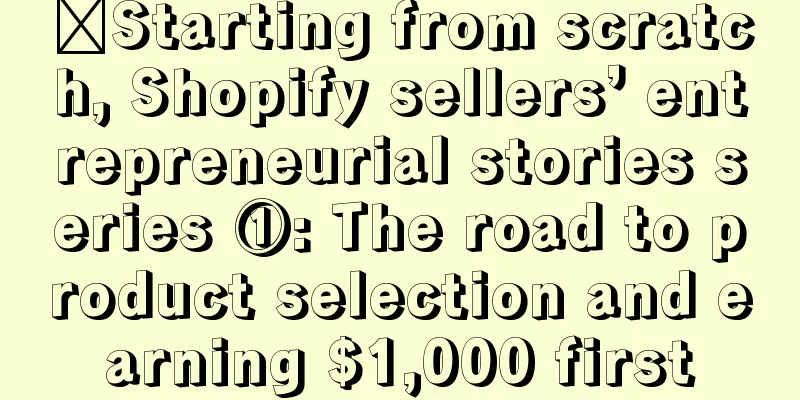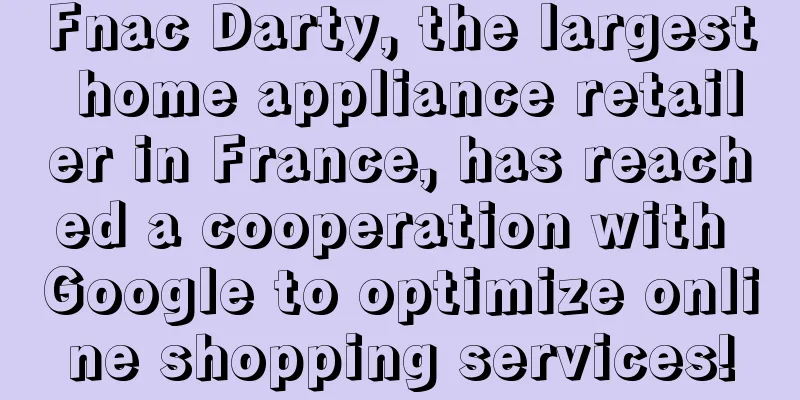Starting from scratch, Shopify sellers’ entrepreneurial stories series ①: The road to product selection and earning $1,000 first

|
[Editor's Note] Sellers, do you want to know what you need to do to create an e-commerce business from scratch and open a Shopify store? In the following series of articles, we will present the steps taken by Shopify seller Tim Kock to achieve his goal of making $1,000 in profit in 8 weeks, and how he approached his small goal step by step. In the first article of the series, we will talk about how Tim selects products and how to set business goals. When you think about opening a store, the first thing you think about is what to sell. However, since you have just started a store, you don’t have many product ideas to come up with. You can only combine existing products or ideas, or develop new products that consumers need. In the opinion of Shopify seller Tim, combining existing products seems to be much easier because if you can combine two or more product ideas to create a new product, then the chances of your product having market demand are greater. So how does he combine existing products, come up with new product ideas and gradually make the products a reality? 1. Combine existing products and come up with creative ideas The first step is to write down all the products that you personally like. The next step is simple. Think about what products you bought the most in the past 6 months. Thinking from the perspective of a consumer will help you better understand and serve potential customers in the future. For example, Tim bought 8 pairs of Jordan or NikeID customized sneakers and 4 backpacks. Then think about two questions: Why buy these products? Why spend so much money on these products? Tim gave the following answers: 1) Reasons for buying Jordan/Nike sneakers:
2) Reasons for buying a backpack: Tim had served with German paratroopers and had to carry a lot of stuff in his backpack. He was looking for a better backpack. He loved backpacking and thought backpacks looked cool and were more practical than suitcases. Combining the above ideas, Tim came up with his product idea: a customizable and very practical backpack. This product is definitely a product he would buy. But it also has a disadvantage, which is that it is expensive. Tim's goal is to make a profit as soon as possible. However, the customizable backpack is similar to Nike's NikeID shoes in a way that only a complete and optimized supply chain can achieve profitability, so he had to make corresponding adjustments to his current ideas: Problem : Custom backpacks are expensive. Solution : Custom rubber patches and sew them onto the backpack. 2. Design brand name and logo You should know that when thinking about brand names and logos, thinking too much will only waste time. Therefore, when thinking about brand names, Tim put all the relevant keywords he could think of into a Google spreadsheet, and finally came up with the following results: Tim loved hiking, so he eventually adapted the word and came up with his own version, using "hyke" as the brand name. The next step is to design your own logo. He is not a designer and does not want to hire someone to design a logo. So he chooses to create a simple and beautiful font logo himself. You can use the logo design tool like him to make a logo according to your personal preferences. Change the background, and Tim's logo appears. After preparing the brand name and logo, Tim began to think about the unique selling point of the product, which is also what other sellers need to do. 3. Think about your product’s unique selling point What you need to think about is: What makes your product and brand different? Why do consumers buy products from you instead of from competitors? Only with a unique selling point can your product be a big seller. Tim's original sales pitch was a customizable backpack, but that was too expensive to implement. His plan now was to sell backpacks + customizable rubber patches, but when he thought he might run into a minimum order quantity issue when looking for suppliers, Tim had to change his mind again. This time he came up with the idea of using a colored spray to customize each rubber patch. If Tim's idea worked, he could hand-make custom backpacks, just like Casey Neistat and his custom suitcases. (Note: Video link : https://youtu.be/M6bdpR_3HCU ) You can then check reviews of similar products on social media platforms to verify whether the product idea is popular. For example, Tim saw this comment on Casey Neistat’s video: It seems that there is a demand for hand-made custom backpacks with rubber stamps. After successfully validating the market demand, Tim can easily improve by offering more different versions of rubber stamps until he can provide customizable backpacks. So far, everything has been going well for Tim, and the next step is to find a supplier. 4. Product procurement Finding a good and reliable supplier is crucial for all e-commerce businesses. The first website Tim visited was Alibaba. Few other websites have so many suppliers. Of course, sellers can also refer to the Amazon seller website navigation to refer to relevant source websites: Tim had dealt with suppliers on Alibaba before and knew how to find them, so he entered some keywords on the website, such as backpack, tactical backpack, military backpack, functional backpack, etc., and saw the corresponding products. Tim's requirements for a customizable backpack are:
Finding suppliers was a time-consuming and labor-intensive endeavor, and he had to look through hundreds of different backpacks before he could actually find what he was looking for. About 10 hours later, Tim finally found 5 backpacks that met his requirements and drew the following table: The next step is to inquire about the prices of the suppliers one by one. Basically, they ask about the minimum order quantity (MOQ), unit price and shipping cost. But in Tim's case, he also needs to ask about the price of rubber stamps. When choosing a supplier, it is not only the price that is important, but also whether the supplier can respond within 24 hours. If a supplier takes more than 24 hours (excluding statutory holidays) to respond to your questions, then you'd better not choose this supplier. Timely communication is the key. After a series of screenings, the most experienced and highest rated suppliers were selected from the remaining ones. Tim chose a supplier with excellent customer service, but having excellent customer service is far from enough. You also need to test the quality of the product yourself before the product is put on the shelf. Therefore, the next step is to order product samples. (Note: Video link https://youtu.be/gewa9l0fUKg ) 5. Order product samples In order to test the quality of the backpack and rubber stickers, Tim purchased two backpacks of different colors and two rubber stickers. Due to the high preparation costs of the manufacturer, a pack of samples with two rubber stickers costs $60, while 100 rubber stickers only cost $80. So Tim decided to spend an additional $20 to order 100 rubber stickers. Including the shipping fee to Germany, the total cost of the backpack and rubber sticker samples was $180, which seemed relatively reliable, so he placed a sample order. A few days later, Tim received a sample of the product. Product Selection Summary In summary, if you are a novice in e-commerce and want to open a store on Shopify, you can create new products or services by combining the creativity or features of existing products. Next, you can use some tools to design the brand name and logo yourself; then you need to think about the unique selling point of your product; remember to screen suppliers, and it is best to choose suppliers who can respond in time. Finally, remember to test the quality of the products you are about to sell yourself. Interlude But not everything went smoothly. A few days before Tim's sample order was to be delivered, the package was detained by customs. It only takes 3 days to deliver from China to Germany, but at first the supplier tried to fool German customs, saying that the package was only worth $7. This did save Tim's customs fees, but many people have done this, so later German customs also found something wrong and finally asked Tim to submit relevant transaction proof before letting him pass customs. Tim sent an email to UPS with a screenshot of his transaction on Alibaba to deal with the customs issue: The lesson Tim learned from this incident is: Make sure the attached invoice shows the actual package value. When doing cross-border business, customs duties are not as important as time. If your buyer pays for shipping like Tim did, he will want to receive the package as soon as possible, and you can't afford to delay. 6. Receive sample order On the day the sample order arrived, Tim was excited but also nervous. He kept thinking about the following questions:
In the end, Tim was very satisfied with the product quality. The backpack, zipper and rubber stamp were all what he wanted, as shown below: The rubber stamp is as shown: Although Tim thinks the product is likely to be sold, he still warns sellers not to start a store immediately after receiving satisfactory product samples. It is best to get feedback from family and friends around you. Generally, don't directly say that this is the product you want to sell, otherwise they will praise the product . Ask them what they think of the quality . You can say that you bought this product to give to others, or you got it as a gift in a lottery, and listen to their real and objective evaluation. Fortunately for Tim, his family and friends seemed to like the product, which gave Tim a little confidence to move forward. Since the minimum order quantity for each color of backpack is 100 pieces (below is a screenshot of the supplier's pricing), Tim has to choose one of the colors. Since Tim has no data to refer to, he chooses black. He thinks black will sell better because it goes with everything. Later, at the beginning stage of the store, you need to calculate the costs. 7. Calculate startup capital and set product prices Tim's overall approach to this new business was to "keep it simple." He wanted to know how much startup capital he would need in the beginning. The price of a backpack is $11.5, and he bargained, and finally the supplier quoted $11.3 per backpack. Although the unit price is not much different, Tim wants to order 100 backpacks, so he can save $20. As shown in the figure, Tim pretends to the supplier that he has to ask his boss for the price because he wants the other party to think that he is just a middleman for communication, not the one who makes the decision. Back to the calculation just now: $1,130 (100 backpacks) + $80 (100 rubber stamps) + $970 (shipping to Germany) + $215 (estimated customs duty) = $2,395 *This amount does not include German taxes, as Tim will file a tax return and get a refund. Of course, there will be more places to spend money in the future, but for now, this $2,395 is the starting cost Tim needs. Next, we need to calculate how many backpacks Tim needs to sell to break even. Put all the data into a Google spreadsheet and calculate two results. One is to offer customers a 30% discount (as shown in column B below), and the other is to sell how many backpacks Tim needs to sell to break even without offering a discount (as shown in column D): If Tim sells the backpacks at $99.99 each and gives a 30% discount, he needs to sell 79 backpacks to break even. If he doesn't sell them at a discount, he needs to sell 44 backpacks to break even. Tim finally priced the backpack at $99.99. He could set his own price, so he would rather raise the price a little higher at first so that he could still lower it later. Besides, for a handmade custom backpack, $99.99 is not too expensive. Although Tim believed that the calculated data was correct, he was still worried that he would not be able to sell the product and waste more than $2,000. But in the end he still placed an order on Alibaba. To keep his worries from coming true, he busied himself setting a very specific goal for his new business. 8. Set business goals Maybe some sellers are like Tim, who set 20-30 goals at the beginning of his business, but in the end, none of them were achieved, because there were too many goals and too many distractions, which eventually led to a loss of focus. Only when the goal is clearly set can it be achieved. It is best to have one goal for each stage. It is common to set a SMART goal. The meaning of each letter is as follows:
Here is the detailed explanation: 1) Specific : A goal like "earn as much as possible" is not specific. A specific goal is, for example, to earn $1,000 at the beginning. 2) Measurable: Another point, you said the more money you make, the better. So how do you know when you have achieved your goal? But if you set a goal like Tim: make $1,000 in profit first. Then it is easy to measure whether you have achieved your goal. 3) Attractive: The goal must be attractive to you, not to others. Tim’s goal is to make $1,000. But that’s not the point. What’s more attractive to Tim is that the product he wants to sell is something he personally likes. It combines two products that Tim uses every day, and the product is his own brand. In addition, whether he can make $1,000 will verify whether Tim will continue to move forward and continue to invest in the business. 4) Realistic: Set a short-term goal based on reality. For Tim, to make a profit of $1,000, he must sell 63 backpacks (or 113 if he gives a 30% discount). Achieving this goal should not be a big problem. 5) Time-bound: When setting a goal, set a deadline. This time point is related to the realistic goal setting mentioned above. If Tim sets a deadline of 10 years to make $1,000, that income is not that impressive. Make sure you can achieve this realistic goal for a long enough time. Considering that Tim runs his own business, 8 weeks should be enough to achieve this goal. Finally, Tim came up with this SMART goal: Tim wants to make $1,000 in profit within 8 weeks of opening the store. So far so good. However, there’s no point in setting goals if no one is interested in your product. So the next step is to find your target audience. 9. Find your target audience Since the product concept itself is based on Tim's own preferences and interests, it is easy for him to find people who are interested in his product: people like him. Although the audience characteristics are already obvious, he still wants to continue to dig deeper. The statistics include not only personal information statistics, but also consumer behavior and Tim's daily life. Finally, Tim summed up the "perfect customer base": 1) Personal information statistics: Male, 29 years old, income of 100,000+, master's degree, entrepreneur/freelancer; 2) Consumer behavior data: Consumers who will rationally consume products such as cars and furniture, and impulse buy products such as sneakers and apples. Tim's daily routine: The above list gave Tim an idea of what kind of target audience he should aim for when selling his product. You can also create similar lists to figure out your perfect audience, which will give you a better idea of how to get started and where to promote your products. These forms make your sales more authentic and make it feel like you are marketing to an individual. To recap, in the last two weeks or so , Tim has:
After finding the target audience, the next step is to take product photos. 10. Take pictures of your products Consumers want to see product pictures. So you have to put pictures of your products in your store, which is a step that you have to consider. Of course, you can ask the supplier if you can use their pictures, but their pictures don't have your product logo, and their picture quality is not very good (see the picture below), so it is better to take the product pictures yourself. The question is, what do you do if you don’t have a DSLR camera or a photography studio? But starting a business means: solving problems. The solution to this problem is simple. You can find people in the local area like Tim did and borrow equipment. Find a good amateur photographer. The product photos taken by amateur photographers will not be much different from those taken by professional photographers, but they are much cheaper. Tim looked up the local place name hashtag #wilhelmshaven on Instagram and also searched a few terms on Google (such as "wilhelmshaven hobby fotograf", "wilhelmshaven fotostudio mieten", "wilhelmshaven startup") This helped him find photographers with DSLR cameras and studios faster and better. When Tim searched for "wilhelmshaven startup" on Google, he found a local sports shoe startup. Tim called them and arranged to meet the next day to discuss in detail. In the end, he exchanged market information with the other party's founder and obtained their camera equipment and a small studio, achieving a win-win situation. The following picture shows the other party's founder taking product photos for Tim: The close-up picture is as follows: In the end, Tim got many high-definition product photos taken from different angles, as well as a very valuable new business partner - a 3D artist. More details will be given in the following article. To sum up, there are many things you don’t need to do yourself and can choose to outsource. As an entrepreneur, sometimes your job is to find the right people to do things for you. It took Tim two weeks to select products, receive samples, and take pictures of the products. Do you want to know what Tim did to make a profit of $1,000 in 8 weeks? Stay tuned for the next article! Text✎ Zhu Meiying/ Statement: When reprinting this article, the title and original text must not be modified, and the source and original link must be retained. |
<<: E-commerce tools: 9 must-have plugins for Amazon FBA sellers in 2019
>>: Single upload product explanation + practical operation
Recommend
Increase GMV and improve purchase rate! Shopify launches new localization tools!
<span data-docs-delta="[[20,"增加GMV提高购买率!Sh...
TikTok will never be banned
text According to CCTV News, the US election has f...
What is Google Adsense? Google Adsense Review
Google Adsense is a quick and easy way to make mon...
What is Sellbrite? Sellbrite Review
Sellbrite is the leading multi-channel inventory a...
What is Micro Intelligence? Micro Intelligence Review
Micro Smart Tool is a cross-border e-commerce stor...
Amazon's pricing system to be rectified? Officials attack it head-on
Recently, foreign media reported that the US gove...
What is WECRO Overseas Warehouse? Review of WECRO Overseas Warehouse
Guangdong Weikelu Supply Chain Logistics Co., Ltd....
Uncovering the secrets of Amazon advertising: understanding the logic and achieving twice the result with half the effort
Amazon offers sellers a variety of advertising for...
These Amazon ad locations have been removed! Sellers are happy or worried...
Amazon's own brands are now in a precarious si...
Amazon sellers' sales dropped by 90%! Another cross-border factory closed down and was pursued for debt
▶ Video account attention cross-border navigation ...
What is Cloud Commerce Cross-border? Cloud Commerce Cross-border Review
Yunshang Cross-border is a leading mobile Internet...
Christmas season online sales data released! Growth rate exceeds last year
In the past two days, overseas data agencies relea...
What is Pinxiaoyidai Operation? Pinxiaoyidai Operation Review
Pinxiaoyi is an Amazon operation service agency un...
Are sellers' shipments frequently canceled? Amazon adjusts storage limits
On Monday morning, some sellers came to ask me wh...
The Middle East "Taobao" collapsed and became inaccessible, suspected to be closed!
So surprised! JollyChic, known as the Taobao of th...









